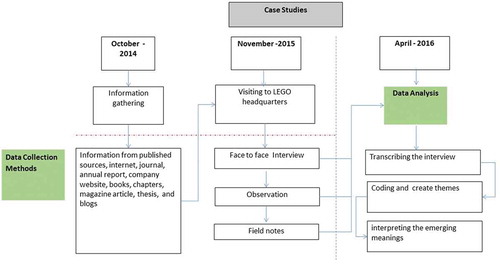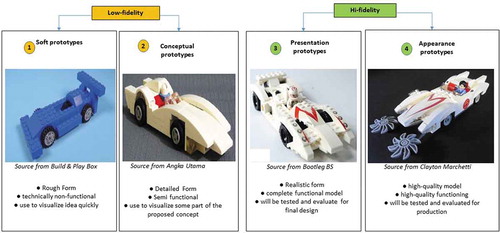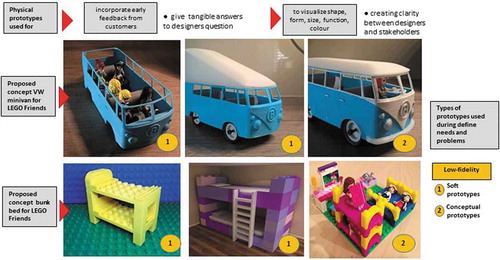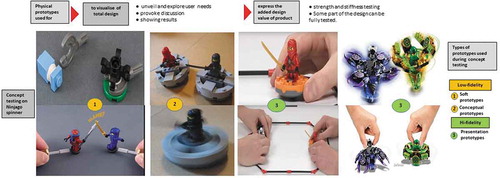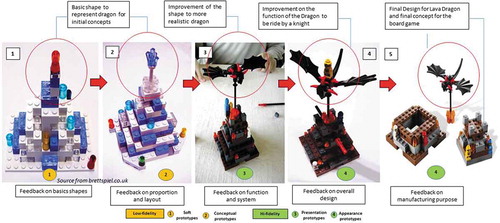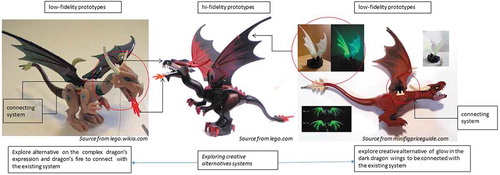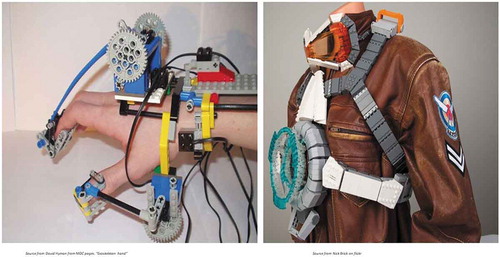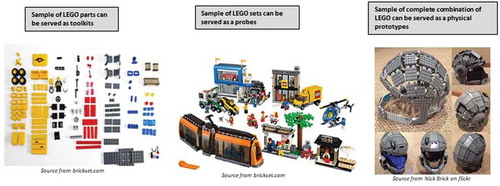ABSTRACT
This study explores the application of physical prototypes to facilitate co-creation activities involving different stakeholders through a case-study analysis. It investigates how physical prototypes support the work of LEGO team at PG2 Front End Design Department (PG2FEDD) in co-creation processes. Additionally, this study will enhance our understanding of how physical prototypes facilitate not only knowledge sharing but also anticipating future user needs. Moreover, the study illustrates how careful deliberation and selection of ‘prototypes in the broadest sense’ improve co-creation practices. Results indicate that LEGO applies low- and high-fidelity physical prototypes iteratively in divergent and convergent co-creation activities to gather constructive and emphatic feedback from the stakeholders. The success of their co-creation processes is due to the strength and distinctive qualities of the LEGO system empowering people to build and foster connection and collaboration.
KEYWORDS:
1. Introduction
Companies are getting more and more interested in co-creation methods and approaches to better understand explicit and implicit user needs (Prahalad and Ramaswamy Citation2013; Mattelmäki and Sleeswijk Visser Citation2011; Dann Citation2018). Co-creation places design thinking methods and tools into the hands of future end-users (and the other stakeholders) early in the front end of the product development process (Heidenreich et al. Citation2015; Sanders and Stappers Citation2014a). Using co-creation methods in design activities will expose hidden needs from different stakeholders more, and bring out more diversified ideas (Hillson Citation2013; Dann Citation2018). Unlike the past, innovation and design-driven companies advocate and practice various forms of human-centred approaches to uncover unarticulated or emerging user needs (Heidenreich et al. Citation2015; Sanders and Stappers Citation2014b). However, Norman and Verganti (Citation2014) question the radicalness of innovation through a human-centred approach. They suggested ‘Design Driven Research’ to achieve radical innovation by juxtaposing radical changes in meaning with radical changes in technology. Verganti (Citation2008) also stressed that structured Human-centred approaches start with user needs and then search for technology in order to satisfy them; therefore they should be considered as market-pull innovation approaches. According to Norman and Verganti (Citation2014), Human-centred design methods for observation, analysis, and ideation, will most likely lead to incremental innovation and not radical innovation. However, Robertson and Breen (Citation2013), Wolf (Citation2014), Docherty (Citation2016) and Gauntlett (Citation2013) revealed that innovative LEGO products, which were developed without considering user needs, led to a significant decrease in the profits. Contrary to the basis of the ‘Design-Driven Innovation’ concept, the product failed to create new meanings. To make up for their loss, LEGO searched for tools that could help them survive in tomorrow’s competitive toy market. LEGO managed to achieve profit and success by following experts’ recommendation to adopt user-centred innovation processes and methods (Robertson and Breen Citation2013; Docherty Citation2016; Gauntlett Citation2013; Wolf Citation2014).
In this study, LEGO was selected as a case, because of how they developed a methodology designed to enhance innovative thinking and creativity, and to improve communication and teamwork, where recreation is combined with imagination, hand-mind connection, and constructionism in different stages of the product development process. The aim of this study is to find out how LEGO used physical prototypes as a tool to facilitate the co-creation of ideas, concepts, and detailed design solutions. Furthermore, it also explores how physical prototypes can be promoted as a valuable mode of representation for communicating design ideas, concepts, and decision-making involving multiple stakeholders. Underlying research questions are: (1) How do designers use physical prototypes in co-creation activities to achieve breakthrough innovative products?; (2) How do designers use LEGO pieces as prototyping tools to develop new LEGO themes and systems through co-creation activities supported by different modes of prototyping?; (3) Given the findings of the case study, how can we reflect on existing theories of co-creation involving physical prototyping?
2. Literature review
Physical prototypes have been applied comprehensively in product development processes over the centuries in producing innovative representations and forms to connect better with the expectations of different stakeholders (Sanders and Stappers Citation2014b; Jensen, Elverum, and Steinert Citation2017; Isa, Liem, and Steinert Citation2015; Subramanya and Chakravarthy Citation2019). Moreover, collaboration with users demonstrated the positive impact of prototyping in innovation (Neyer, Doll, and Möslein Citation2009; Antorini, Muñiz, and Askildsen Citation2012; Hillson Citation2013; Ramli Citation2014). Prototyping facilitates the creation of shared mental models among participants, clears misunderstandings, creates emotions through haptic experience, and fosters coordination (Neyer, Doll, and Möslein Citation2009; Ramli Citation2014; Sanders and Stappers Citation2014a).
According to the horizontal axis of , physical prototypes can be classified into four categories: (1) Low-fidelity Soft-prototypes, (2) Low-fidelity Conceptual Prototypes, (3) High-fidelity Presentation Prototypes, and (4) High-fidelity Appearance Prototypes. Low-fidelity physical prototypes (Soft, and Conceptual Prototypes) are particularly rough representations to help the designers to unveil, explore, and anticipate stakeholders´ needs. The purpose of these prototypes is not to search for the embodied design solution nor to impress stakeholders of the final outcome, but to complement problem-solving activities. Therefore, it can be said that Low-fidelity prototypes aim to demonstrate ‘proof of concept’ (Lim, Stolterman, and Tenenberg Citation2008; Ulrich and Eppinger Citation2012; Isa and Liem Citation2014), especially in early co-creation activities. They are also more suited for communicating multiple design needs and exploring design variations with various stakeholders compared to high-fidelity prototypes. By applying low-fidelity prototypes strategically in the design process, new insights concerning people´s physiological and psychological needs, as well as innovative design ideas and concept solutions may emerge through the interaction with these prototypes (Sanders and Stappers Citation2014b). Moreover, low-fidelity prototypes have proven to be more flexible and cost-efficient when design changes need to be made.
Table 1. Categorisations and characteristics of physical prototypes and its usage during co-creation process
The purpose of hi-fidelity porotypes is to clarify the physical embodiment and production feasibility as they are able to show a certain level of shape complexity. High-fidelity prototypes, as ‘proof of process’ (Lim, Stolterman, and Tenenberg Citation2008; Ulrich and Eppinger Citation2012), contain all conceptual and detail design suggestions on how the product can be produced. Furthermore, they can also be used as ‘a proof of production’ (Lim, Stolterman, and Tenenberg Citation2008; Ulrich and Eppinger Citation2012) to demonstrate that the product has gone through a complete and effective design and manufacturing process.
The vertical axis explains typical applications of low- and high-fidelity prototypes. These applications are classified according to ‘Explorative purpose’ – (A) Communication, (B) Visualisation, ‘Design Stage’ – (C) Proof of Ideas, (D) Modification and ‘Functionality’ – (E) System and Mechanism, (F) Physical Testing, and (G) Functionality Testing.
The horizontal prototype, representing prototyping types has been juxtaposed with the type of application to map out more concretely the purpose of each prototyping according to application and its role in the design process.
In co-creation processes, prototyping can take place in three ways. Firstly, designers and participants develop prototypes together to share and communicate their ideas. Secondly, designers present prototypes to the participants to probe for initial insights. Thereafter, these prototypes are jointly further developed to dive deeper into the problem. Thirdly, designers propose semi-completed prototypes to the participants for them to further develop these prototypes and at the same time gain additional user insights. The designer merely acts as a facilitator. (Hillson Citation2013; Isa, Liem, and Steinert Citation2015).
However, some researchers suggested not to build physical prototypes too early in the design process, as it can be expensive, time-consuming and not always necessary (Dow, Heddleston, and Klemmer Citation2009; Stowe Citation2008; Viswanathan and Linsey Citation2009). Others claim that physical prototypes should be used in early design development to enhance communication between stakeholders and designers in order to produce breakthrough products (Jensen, Elverum, and Steinert Citation2017, Sanders and Stappers Citation2014b; Isa, Liem, and Steinert Citation2015). This has led to the exploration of how significant physical prototyping is in supporting human-centred activities to imagine future objects, future experiences, and future ways of living. According to Sanders and Stappers (Citation2014a), the implementation of physical prototypes in human-centred design activities underlines a shift in using models and prototypes to become a platform for interaction in all phases of the design process. Sanders and Stappers (Citation2014b), Lim, Stolterman, and Tenenberg (Citation2008) and Coughlan, Suri, and Canales (Citation2007) underlined this new role of prototyping through the embodiment of five primary objectives as shown in . However, some information is missing about the purpose and the effectiveness of this new way of prototyping in enhancing designers´ creativity to produce radical innovative ideas (Hess Citation2012; Isa, Liem, and Steinert Citation2015; Hillson Citation2013). Hence, this study is designed to address this gap by investigating and discussing aims, and advantages of these new roles of physical prototypes in co-creation processes.
Figure 1. The changing roles of prototypes adapted from Lim, Stolterman, and Tenenberg (Citation2008) and Coughlan, Suri, and Canales (Citation2007)
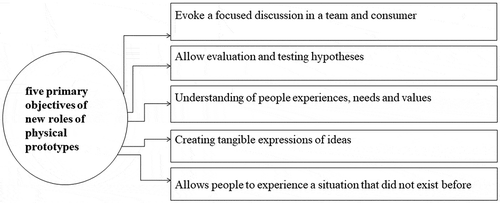
In a recent study about collaborative prototyping, Bogers and Horst (Citation2014) found that prototyping helps participants to understand design constraints, and how usability problems emerged and are solved through active engagement and experimentation. To gain the collaborative advantage, more innovation and design-driven companies advocate and practice various forms of user research to uncover unarticulated or emerging user needs. Through a range from rough sketches to full-scale prototypes (Holmlid and Evenson Citation2008), they aim to enhance the accuracy of feedback conversations by providing a mechanism for decision-makers to create more vivid manifestations of the future (Liedtka Citation2014).
3. Co-creation activities within LEGO
Co-creation, as a relatively new concept for innovation, can be perceived as a design activity where two or more people are involved in collective, creative problem solving and idea generation (Prahalad and Ramaswamy Citation2013; Sanders and Stappers Citation2014a; Ali and Liem Citation2015; Heidenreich et al. Citation2015). According to Sanders and Stappers (Citation2014b), innovative products and services may be developed more efficiently once designers adopt design thinking, making and acting to break down the barriers between consumers, enterprises, and stakeholders. As such, design thinking can be useful to complement co-creation activities, if applied and guided properly according to selected principles, models, and theories (Prahalad and Ramaswamy Citation2013; Sanders and Stappers Citation2014b; Isa, Liem, and Steinert Citation2015; Docherty Citation2016).
As per today, LEGO´s emphasis on co-creation approaches and methods has been crucial for their success in structuring their product development activities and coming up with innovative solutions. This success is partly attributed to LEGO enthusiasts or customers who share a strong bond with the company because of their childhood experiences. They are therefore more willing to engage in unrestrained dialogues and exchanges of new ideas and concepts with multiple stakeholders (Robertson and Breen Citation2013). For LEGO, collaboration between user bases such as clubs of experts, lead users, customers, and the broader circle of other stakeholders is essential to achieve breakthrough innovation (Robertson and Breen Citation2013; Ranscombe et al. Citation2019; Gauntlett Citation2014). In the LEGO context, stakeholders, classified as internal and external people, are capable of influencing the future strategy of the organisation. External stakeholders are children, customers (parents, buyers), and retailers, whereas internal ones are builders, group theme members (Ninjago, City, Chima, etc.), prototypers, engineers, marketers, facilitators, scriptwriters, designers, and top management.
According to Wolf (Citation2014), LEGO applied a variety of co-creation methods and tools in their product development processes, both virtually (crowdsourcing and open source innovation) and physically (face-to-face methods such as co-creation workshops, insight gaining sessions, and collaborative making). Methods and tools were selected, dependent on the purpose and how closely customers are to be associated with it. According to LEGO’s innovation philosophy, the introduction of new ideas that improve products, experiences, communication, business development, and processes does not mean that the product should be ‘radical’. They proposed a new innovation model comprising three types of innovation approaches: ‘to adjust’, ‘to reconfigure’ and ‘to redefine’, according to aim and context (Robertson and Breen Citation2013).
4. Theoretical framework
This section aims to establish a conceptual framework for better understanding the use of physical prototypes with respect to knowledge integration as well as experience and expertise sharing in co-creation processes.
Undoubtedly, the aims, advantages, and challenges of using physical prototypes as a strategic design tool have been widely discussed with respect to their contribution to design thinking processes, as well as their ability to more effectively and efficiently manage design activities (Jensen, Elverum, and Steinert Citation2017; Hallgrimsson Citation2012; Isa, Liem, and Steinert Citation2015; Sanders and Stappers Citation2014a; Subramanya and Chakravarthy Citation2019). Physical prototyping has been a significant activity as a communication tool in design activities to develop understanding between stakeholders to study significant insight and design problems (Skogstad and Leifer Citation2011; Meinel and Leifer Citation2011). Unfortunately, limited research has been conducted to investigate the purpose and effectiveness of physical prototypes in early idea generation involving stakeholders to solve complex problems, as well as how the design tools have contributed to enhance designers´ creativity in co-creation activities (Hess Citation2012). The model presented in synthesises the theoretical issues to the following research areas: i) Design Thinking for innovation (Brown and Katz Citation2019), ii) new roles of physical prototyping in design process (Lim, Stolterman, and Tenenberg Citation2008; Coughlan, Suri, and Canales Citation2007), and iii) human-centred design process (Hillson Citation2013; Zhang and Dong Citation2008; Bartl Citation2009; Gould and Lewis Citation1985). This model describes how physical prototypes give value and contribute to design thinking by thorough understanding (empathy) through direct observation of defining what people need and problems (Brown and Katz Citation2019). In other words, physical prototypes help to give insight into the right problem to be solved and contribute to the designer´s awareness of the importance of design thinking processes with respect to managing structured and collaborative design processes (Brown and Katz Citation2019; Hillson Citation2013; Sanders and Stappers Citation2014a). The model in also illustrates that physical prototypes in human-centred design processes can be considered as a medium of interaction (evoke) between stakeholders and designers to facilitate the development of innovative ideas and concepts (create). It illustrates how designers play a key role in shaping the representations to test ideas (evaluate), which then can be distributed to non-designers to imagine future objects, future experiences, and future ways of living (experiences).
Figure 2. The advantages of physical prototypes “used in”, “used for” and “gives value” to iterative human-centred design process adapted from Brown and Katz (Citation2019), Hillson (Citation2013), Sanders and Stappers (Citation2014a), Lim, Stolterman, and Tenenberg (Citation2008) and Coughlan, Suri, and Canales (Citation2007)
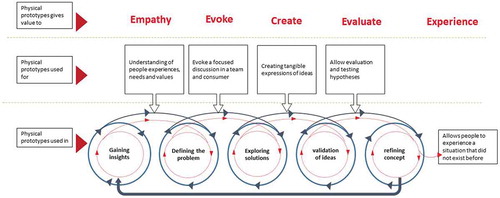
Liem and Sanders (Citation2013) revealed that human-centred innovation processes and methods emphasise observation, collaboration, interpretation, visualisation of ideas, and rapid concept prototyping which ultimately influence how a company strategizes its current product and service portfolio or plans new products for the future (Liem and Sanders Citation2013; Bartl Citation2009). To anticipate future needs, Sanders and Stappers (Citation2014b) proposed alternative methods and tools to analyse people’s needs, wants, and design problems in human-centred design. They proposed a co-creation process where designers and stakeholders are involved in creative acts of making by involving probes, toolkits, and prototypes during pre-design and design development processes. A revised framework is proposed () to explain the connection between probes, generative toolkits, and prototypes in co-creation activities (Sanders and Stappers Citation2014a).
Figure 3. Framework of three approaches to making is positioned relative to the mindsets and phase in design process adopted from Sanders and Stappers (2014)

Probes are applied in the pre-design stage in a user-centred design context, to provoke and elicit responses and reactions from stakeholders. They are tangible artefacts, comprising maps, postcards, cameras, puppets, and diaries, which allow stakeholders or designers to document particular feelings, events, or interaction (Sanders and Stappers Citation2014b; Mattelmäki Citation2006; Ali and Liem Citation2015). Generative toolkits assist designers and stakeholders to jointly create new ideas and concepts for future needs. The toolkits are combinations of 2D and 3D components. For example, straws, buttons, various organic and geometric block shapes, puzzles, and notes suitable to be used in collaborative activities. These visualisation tools allow them to communicate and create ideas in a collaborative manner. Prototyping can be seen as a tool for ‘designing for’ and ‘designing with’. It aims to evaluate and concretise more viable design concepts.
The overlap among the three representation tools; probes, toolkits, and prototypes emphasises the importance of making as a joint creative and knowledge gathering activity with multiple stakeholders throughout the design process. It is also an effective way of motivating people to express their ideas.
Focusing on the involvement of stakeholders in design and decision-making processes, theoretical frameworks, as discussed in this section, were elaborated through empirical studies to determine alternative methods and tools to analyse design problems, broaden the creative space, and synthesise design concepts within acceptable time frames.
5. The influence of prototyping on divergent and convergent thinking
Prototyping for design practice differs significantly from prototyping for design research. For the practitioner, prototyping is an activity that will help to narrow the conceptual space until a commodity is produced (Jensen, Elverum, and Steinert Citation2017; Hallgrimsson Citation2012; Isa, Liem, and Steinert Citation2015; Subramanya and Chakravarthy Citation2019). The process is divergent and convergent, consisting of experimenting with different possibilities for various aspects of the commodity, allowing the designers to gain additional information before making each choice (Liem, Ruecker, and Alfonso de la Rosa Citation2017; Subramanya and Chakravarthy Citation2019). Design practitioners assume the existence of an optimal solution that can be achieved by a serious process of research for design. Such process is very useful when trying to reduce uncertainty and achieve a faster tangible result. In this context, designers assume that every prototype is a beta version of the final commodity to be produced, an unrefined version that could help them correct the aim of the process to reach the expected solution. For the design researcher – practitioners, prototyping is also a learning tool, prioritising knowledge acquisition, rather than the commodity at the end. Through a divergent and convergent process, every prototype developed and implemented expands the conceptual space and the view of the future state of the system, so that each iteration results in a larger understanding (Liem, Ruecker, and Alfonso de la Rosa Citation2017). Since design investigates on the possible future scenarios of reality, the goal of the researcher-designer is to understand the nature and complexity of the future state of the system. In this sense, prototypes can be used as probes into that future state due to the fact that once implemented they unveil real interactions and transformations of the system.
6. Methodology
A comprehensive literature review has been conducted, explaining how LEGO evolved from firm-centric to consumer-centric company. This literature review was complemented with a case-study research to gain a deeper understanding how LEGO used prototypes to develop innovative products and systems in the early exploration, conception, design, and detailing stages with various stakeholders to capture value-rich end-user experiences. According to Yin (Citation2017), Eisenhardt (Citation1989) and Flyvbjerg (Citation2006), case-study research can be applied in many disciplines, such as psychology, business studies, linguistics, sociology, and design. This case-study research comprised a collection of secondary sources including documents, archival records, etc., to complement the primary source of findings through direct observations, and interviews (Yin Citation2017). Semi-structured and informal interviews were conducted with current and former LEGO employees.
As LEGO participated in this research project with past, but real projects, this case-study research has been angled towards investigating a real-life phenomenon relative to a single individual, programme, or event, with the purpose of learning more about unknown or poorly understood situations (Leedy and Ormrod Citation2005; Creswell and Poth Citation2016).
The research questions seek to answer why LEGO is motivated to engage in early exploration, design and development activities through co-creation, as well as how it influenced their other design practices. As such, a single-case study method was applied followed by a cross-case analysis study to improve existing methodologies, tools, and techniques used in co-creation, as well as to gain a deeper understanding of new contexts and complex situations for developing innovative products and services (Yin Citation2017; Creswell and Poth Citation2016; Flyvbjerg Citation2006). Findings were constructed and validated from interviews and literature studies. This resulted in a theory-building exercise, where different prototypes, their applications, and how they contribute to the design process were brought together, as shown in .
6.1. Background of the empirical study
Contact was initiated with the senior creative director at PG2 Front End Division in 2014. The actual case-study research took place between October 2014 and April 2016, Ppior to the first Billund (Denmark) visit in November 2015, a background study about LEGO company and their innovation processes was conducted from publicly available sources such as websites, etc. Employees from PG2 Front End Division Department (PG2 FEDD) were pre-selected to participate in the case-study research, based on (1) their experiences with co-creation processes, methods, and activities, (2) their roles and responsibilities in the organisation, and (3) their legitimacy to make decisions.
The empirical research process is comprised of the following stages (see ). The researcher was given a tour of the LEGO headquarters complex, innovation studio, themes department, and prototypes department, where they showed how shapes, textiles, and prototypes were produced. Alongside the interview sessions, which happened within a five days timeframe, design activities at workplaces, discussions during stand up meeting, kids tests, and model-making activities during idea development meetings, were observed.
6.2. Data collection
Multiple data collection approaches were conducted, such as document gathering, observation, and personal face-to-face interviews. Theoretical elements from: (1) prototyping and its applications () (Lim, Stolterman, and Tenenberg Citation2008; Ulrich and Eppinger Citation2012; Isa, Liem, and Steinert Citation2015; Subramanya and Chakravarthy Citation2019), and (2) the human centred design process () (Brown and Katz Citation2019; Hillson Citation2013; Sanders and Stappers Citation2014b; Lim, Stolterman, and Tenenberg Citation2008; Coughlan, Suri, and Canales Citation2007; Subramanya and Chakravarthy Citation2019) were used as a foundation to formulate the interview questions. Interview questions were divided into two parts to address the research questions. The first set of questions was developed to assess LEGO´s co-creation visions, capabilities, and practices. The second set of questions aimed to uncover the effects of prototypes in co-creation activities.
Information from books, journals, annual reports, and official websites on LEGO´s innovation and co-creation processes, complemented and provided more nuanced insight into the field studies. During a second site visit at LEGO, interviews were conducted with the design director, executive designer, junior designer, designer, marketing, and model maker at the innovation department PG2 Front End Division Department (PG2 FEDD) at LEGO company. Each participant was interviewed for approximately 2–3 h. Interview questions were subject to minor amendments to suit the context and interview participants. Where and when needed probing questions were used in the interviewing process. Upon the participants’ consent, interviews were video recorded. A table (see ) with particulars about the data collection interview is shown below.
Table 2. Participants profile for data collection interviews
6.3. Data analysis and reporting results
Six interview transcripts comprising 12,000 to 24,000 words each were coded and analysed using a qualitative analysis software Altlas Ti (https://atlasti.com/). The analysis was based on the selection of keywords from the transcripts regarding participants’ reflections during the whole process. The initial phase involved searching for themes, coding and categorising quotes from the transcripts. Themes, as shown in were deduced from real design activities (What LEGO-designers actually do in practice), as well as design process and co-creation theories. Main coding was conducted by the first author of this study. Reliability issues were addressed by involving three other researchers to validate selected coded sections of the transcripts. Emerging meanings were interpreted from the data based upon patterns and by identifying regularities for possible explanations of major themes. A similar coding process was applied in the analysis of field notes. To finalise the data analysis, coded transcripts of field notes and interviews were compared, and evidence from the case studies analysed, following theoretical propositions, as outlined in the literature review. This study concluded with a discussion to report the most significant findings of this study, present practical implications, assess its limitations, and offer opportunities for further research.
Table 3. Roles of physical prototypes, stakeholders, and designers in different co-creation activities with different methods
6.4. Results and findings
Results showed that physical prototypes were categorised (see ) from literature reviews, observations, and interviews using a theory-building exercise. Based on the interviews, all the participants agreed that the classification of physical prototypes helped them to manage their design process more effectively and select the most suitable methods for solving complex system and design problems. Such classification also assisted these participants to decide when and where to implement co-creation activities. Using low and high-fidelity prototypes iteratively in every co-creation process, the designers were able to create emphatic solutions for the right market.
The core of the development at LEGO is to maintain the emphatic contact with stakeholders as shown in . is a consolidation of data from the (1) interviews and field note activities, (2) theoretical elements from; (i) prototyping and its applications () and (ii) the human centred design process () are used as a foundation to summarises designers´ activities in co-creation using different categories of physical prototypes in suitable methods, following what are the roles of designers, stakeholders, and prototypes contributed in the processes. Particularly, the designers valued the contribution of prototyping as a design development tool, because it facilitates divergent and convergent exploration of ideas, as well as more accurate evaluation of the design through interactions with the prototype/model. Each of the representation tools has their own strengths and weaknesses with respect to how they are being applied and how they contributed to each of the stages in the design process.
Any of the processes mentioned in can be a starting point for the team to generate ideas. How the designer selects a typical starting point depends on the project brief they receive from management. At every stage, the team watched the stakeholders engage with the prototype they produced to proceed to the next level. According to the team, physical prototypes assisted in answering questions which arose during critiques and brainstorming sessions. Physical prototypes and co-creation processes have been considered one of the most important and valuable tools and methods to create innovative products at PG2 Front End Division. Physical prototypes were used in different ways involving different stakeholders in concept development at the department because they accelerate innovation processes, lower costs, increase profits, anticipate stakeholders’ needs, mitigate failure, and give insights for new ideas. No ideas can progress without the feedback and insight from stakeholders. provides an overview on how physical prototypes contribute to co-creation processes at the department. The details on how physical prototypes were used during co-creation processes are discussed in the upcoming sections supported by the selected case involved.
6.5. Study insights and experiences
During this stage, the team started to empathise by connecting with people and their experiences in specific contexts based on the project briefing from management. Low- and high-fidelity physical prototypes were useful in observations and interviews to gather stories from stakeholders and understand the complexity of the problem and future needs. Moreover, designers encouraged people to talk when interacting with physical prototypes. This resulted in different people sharing different rich stories for potential design to the designers to get promising insights faster and earlier in design process. During this stage, the designers involved more low-fidelity prototypes to help them build practical versions of inspired products and also to catch potential design problems. One of the participants explained:
… when we have study insights test, we show them the multiple types level types of prototypes, we sitting in the same room and we asked questions based from what we see and what they said, when we do our global insight tests, it’s a children psychologist … children psychologist and experienced facilitators will asking the question using physical prototypes as a probes, because, for example the kids will say this is awesome, but what is behind awesome what does awesome means? Then we need or they need to dig deeper behind the words, if they say this is really cool, then what is cool ? and why is it cool ? so what you understand the words behind cool …
6.5.1. Sample case 1: developing new playing experiences: LEGO Nexo Knights theme
This concept was inspired by unarticulated consumer needs from all over the world, turned into new insights and meanings. Different physical prototypes () were used in multiple research approaches such as ethnography, probing dialogue, storytelling, and role playing to gather insights and to observe how children would interact and engage with potential ideas. Designers found that children have an obsession with ideas involving physical and digital interaction. This insight inspired them to create new playing experiences that combine physical toys, cartoon series, and digital gaming. Other insights revealed that children were interested in history, mythology, and science fiction. As such, the designer capitalised on these insights to create futuristic medieval knight adventures that invite children to explore playing with LEGO using digital apps and digital gaming, while also following an animated-television series. Adopting a futuristic perspective, designers created robotic power armour and weapons, a high tech gigantic robot vehicle, and a mechanical horse to create features and characters that children preferred based upon their imaginations and observations. To increase playing experiences, more than 150 unique digital knight power collections were developed (sample shown in ) in both physical (toys) and digital (apps and computer games) that children upload with their gadgets.
6.6. Defining people needs, wants, and problems
In this stage, conversations among internal and external stakeholders were facilitated through several rounds of iterative prototyping. These physical prototypes enhance the discovery of hidden needs, explore new meanings, help formulate design problems, and as a result, conceptualise future design solutions. These conversations were facilitated and guided by designers, who also contributed to their own design insights. Iterations enabled designers to gradually materialise the design solution from lower to higher levels of resolution. The participant also added:
… The kids are usually not giving the ideas, they usually making tweak or they improving the ideas. The kids like to explore with lower level prototypes because prototypes are real and can be modified, you can touched them, feel them an it is universal language, words are not real for me and they don’t inspire me it is difficult to understand words around the table, sketch is more real because everyone can understand what sketch can be, but prototype is super real because it … it. it’s can really explain what the experience can be like …
6.6.1. Sample case 2: LEGO friends play theme for girls
This case introduces ‘LEGO Friends Play Set’, aimed at attracting more girls to connect better with the brand and become LEGO customers. The theme ‘LEGO Friends’ was developed using co-creation processes for a period of 4 years, involving more than a hundred tests with physical prototypes. Needs and wants were emphasised. Using an incremental design strategy, the concept was refined based upon the needs and wants of girls. Prototypes were mainly communicating gender normative themes such as beauty, fashion, cooking, but also action-adventure activities to be tested with girls. As a result, detailed prototypes that have bright colours, are realistic, create an emotional connection, and are most suitable for role play were most popular when tested to stakeholders, as shown in (Wolf Citation2014; Robertson and Breen Citation2013).
6.7. Exploring design solutions
Exploring design solutions descriptively, through sketches or CAD, may not be inspirational nor give a realistic feel for designers. In this stage, designers brainstorm with stakeholders through conversations with physical prototypes, and the exploration of ideas, concepts, and functionalities. Low-fidelity prototypes are developed, explored, and cross-shared among designers and internal and external stakeholders to develop empathy, convince, discuss, and debate tangible concepts. The participants added:
… It would be to put A,B,C low-fi and hi-fi prototypes in front of the kids and observe what is the energy and passion that they provide just looking at those A,B,C which those prototypes will they takes first and which will they have more fun with and after wards we have the dialog with them on what was more interesting to play with A, B and C …
6.7.1. Sample case 3: developing ‘Ninjago Villains’
‘Ninjago Villains’ was developed to counter the established theme of Ninja heroes. Six different types of villains such as monkeys, robots, skeletons, and semi-human lizards were prototyped and tested. Initial feedback through first-hand role play revealed that skeletons were the most popular villains. The team then focused on iteratively developing the skeleton concept using physical prototypes (see ) in greater detail by adding multiple elements such as coloured armour, various expressions, and different details on the skeletons’ scalps. The designers focused more on these elements to get multiple solutions and responses from the stakeholders on main components and also details of the accessory elements. This process of detailing and testing involving physical prototypes continued until a skeleton concept was materialised and specified for production (Gauntlett Citation2014; Wolf Citation2014).
6.8. Concept testing
During this stage, designers aim to test their ideas cheaply and quickly. Questions were developed to test and validate the proposed concepts. Engaging physical prototypes in a structured evaluation process specifically encourages passive users to participate in open discussions. During this session, low physical prototypes with raw combinations of LEGO pieces and other materials were built to test core ideas and create quick tangible experiences for stakeholders and designers to engage in a spontaneous discussion. In this case, the designer stated that:
“ … within in the last ten years, it always been tested by kids, always, always been with consumer tested, so we have kids point of view on what we develop on a couple of the project, I’ve been more involved in try to be a bit more developing. a bit more openly with the kids … ”
6.8.1. Sample case 4: developing LEGO Ninjago Spinjitzu’s spinner
LEGO designers wanted to develop something that appeals to children to complement the ‘Ninjago’ theme. Everlasting, iconic, and popular toys were examined, such as yo-yos, marbles, and spinning tops. The team decided to select spinning tops to guide the development of their new spinning concept. A series of brainstorming sessions involving LEGO designers, marketers, engineers, and prototypers from various departments were organised to explore design solutions using low-resolution physical prototypes. The team developed more than 60 different spinner prototypes to show a pair of spinning ninja mini-figures fighting (). By using low-fidelity physical prototypes, it was easier for the team to propose and co-create the mechanism of the spinner’s eject button for the mini-figures to pop-off spontaneously. The team also managed to solve a difficult challenge with the mechanism to get the model to spin for several rounds without wobbling, as shown in . Furthermore, designers were keen to find out how clear the accompanying instruction manuals were. They subjected the prototype spinners to tests, where only written instructions were given to the children to figure out how to operate them. Difficulties in interactions with the spinners were immediately fixed by addressing the instruction manuals for the spinner prototypes. An iterative process of rectification and testing took place continuously until a match was found between age, clarity of manual, and spinner (Robertson and Breen Citation2013; Wolf Citation2014).
6.9. Improving concept from feedback
Iterative design cycles happened more frequently in this stage. Designers shared feedback from the test results with internal and external stakeholders and identified areas for minor improvements as highlighted by the physical prototypes. During this refinement stage, the designer is still responsible for ensuring that there is no deviation from the design intent, specifically in terms of overall appearance and meaning. The final concepts were materialised into high-quality prototypes and a second round of iterations followed by involving stakeholders to critique and improve the design until the design met user needs. The modeller said:
… And then we pick 3 or 4 concept from the feedback, where will going to modified the prototypes and make them make them even much better and really make them work as actual final design in a one to one size and then we test again to the kids, to the team, and then we see how they handling the prototypes and getting respond from the kids and team on what to improve, so it is per … you know, its new playing features, it can be … it is actually can be between 10 to 50 prototypes on one concept …
6.9.1. Sample case 5: LEGO board game
In this case, designers developed a buildable dice out of LEGO components that can be used as an icon for any board game. It took 16 months for designers to perfect the dice design with the help from different stakeholders. Thereafter, several board game concepts were developed, which could be easily built and modified, motivating children to engage in competitive playing experiences with their families. More than a hundred ideas were initially constructed using low-fidelity prototypes comprising thin sheet paper boards, standard LEGO bricks, etc. Thirty ideas were further developed by conceptual prototypes. Concept testing with families took place within a period of 7 days in Denmark, Germany, and the United Kingdom. During the first round of testing, families were asked to reinvent the rules of the board games. In this way, a clear picture emerged on how the rules and elements of the game evolved. In the second round, 3–5 final prototypes with variations were subjected to the opinion of these families. Additionally, designers probed questions based on what they saw during the observations to complement what had been reported. The example of the Lava Dragon board game () shows how the physical prototype evolved during development. The initial concept was explored and illustrated using two rounds of low-fidelity prototyping, where basic combinations using LEGO components were made. The first prototypes were built to gain feedback on how the shape could be improved, whereas the second prototypes focused on the proportions and layout of the design. As the game developed, the design also evolved from a conceptual to a detailed level (third development) focused on system and function. In the final two developments, feedback was sought on the overall total design (fourth development) as well as the methodology for manufacturing (fifth development).
7. Discussion
LEGO elements are comparable to other modes of representations in terms of communicating feelings, living patterns, thoughts, and values. (Sanders and Stappers Citation2014a; Mattelmäki Citation2006). Its resolution and flexibility, characterised by variable shapes and sizes of bricks, facilitate conceptual design to a significantly detailed level, allowing designers and stakeholders to easily envision future ideas and concepts. However, when juxtaposing LEGO as a prototyping tool with its purposes and stages of the design process, several differences can be observed. These differences have led to answering the research questions as follows.
7.1. How do designers use physical prototypes in co-creation activities to develop innovative LEGO products?
The analytical findings provided new insights on how different types of prototypes, according to their application, should contribute to the development of new LEGO concepts (), following a human-centred design process. These findings also suggest how to use physical prototypes iteratively in co-creation processes to create active participation among experts, potential users, and other stakeholders. The seamless application of different prototype resolutions at different stages of the design process, while supporting divergent and convergent co-creation activities increases the chances of developing innovative solutions (). Hereby, it is important that the designer decides what the purpose and use of these physical prototypes should be, to solve design problems, enhance design experiences, and materialise the design outcome. For example, in early co-creation stages, a wide variety of low-fidelity prototypes, comprising ‘soft prototypes’ and ‘conceptual prototypes’, complement the ambiguity of 2-D sketches and drawings to assist designers and stakeholders in generating insights, solving design problems, and addressing user needs. Perceived holistic form and its relation with subordinate form elements as well as proportions determine ancillary meaning.
Figure 11. How designers used and classified physical prototypes in divergent and convergent iterative co-creation process

When transitioning to the conceptualisation and refinement stages of the process, low-fidelity prototypes complements accurate high-fidelity prototypes for assessing functionality, geometry, and aesthetic appearances, as well as keeping the ‘exploratory space’ for developing future directions and projects (see ).
The parallel and iterative use of high- and low-fidelity prototypes is typical during these generative and evaluative stages. Although the resolution of the design is expected to increase, low-fidelity prototypes are still useful for exploring detailing issues, which have not yet been solved as well as to make aesthetic, ergonomic, and technical refinements.
In the final stages of the evaluation process, high quality, fully functional physical prototypes are generated to endorse the prototype design for manufacturing and assembly. Low-fidelity prototypes play a supporting role in highlighting and solving minor design issues.
The seamless application of different types of prototypes in all stages of the co-creation process shows that innovation through LEGO´s philosophy is based on an ‘open system’ concept, which does not strictly limit ‘what representation should be applied’, ‘when in the process’, and ‘who should be involved’. However, there are some typicalities, which characterise the LEGO co-creation and design process: (1) Implementation of hi-fidelity prototypes in early stages to help designers and stakeholders to gain an understanding of present themes, as well as technical systems in terms of functionality and assembly. Such understandings assist the designer in determining directions and potentials for innovation. (2) Continued involvement of low-fidelity prototypes in the verification and improvement stages signifies the dominance of the ‘LEGO system’. The purpose of low-fidelity prototypes is not limited to solving minor design issues, but also aids in the continued exploration of ‘creative’ alternatives at a system component level, alongside the detailing and materialisation of the overall system concept. shows the example of how low-fidelity prototypes were used in parallel with high-fidelity prototypes during LEGO dragon’s concept final design process to solve the problems of interconnecting complex parts with the existing systems.
7.2. How do designers use LEGO pieces as prototyping tools to develop new LEGO themes and systems through co-creation activities supported by different modes of prototyping
According to the participants, the combination of LEGO sets, parts, and bricks was used intensively during all stages of the co-creation process to facilitate interactions with stakeholders. As a system of unlimited interconnecting objects (Gauntlett Citation2014):
The durability and flexibility of LEGO pieces make it easy for designers and stakeholders to create physical prototypes which represent what they want to communicate.
Using LEGO pieces to create and present ideas do not require significant technical skill.
Modifications can easily be made without involving complex deformation processes.
Prototypes can be constructed for usability testing with different stakeholders without significantly compromising technical functionality, appearance, or usage ().
It can be easily adapted to work with non-LEGO elements in prototyping.
The versatility of LEGO systems in the development of prototypes facilitates storytelling among different stakeholders. It was easy for users to share experiences and for designers to probe questions when interacting with these prototypes. Insights assist designers to better understand what needs to be changed and what should be kept in the design. In terms of accurate representation, working with standard LEGO pieces is sufficient for the early stages and sometimes even the final stages of the development process. Such versatility also makes it easier for designers to be active in ‘developing’ and ‘making’ the ideas according to intent.
The LEGO system was created from ‘system of play’ principles, where all pieces fit together. It allows people to build and rebuild existing concepts with the same set of components. Because of its system nature, LEGO turns out to be a great prototyping tool to engage different stakeholders in creating and rebuilding endless solutions. The system builds a closer relationship between designers and stakeholders, not only serving as a testing tool but also as a tool for persuasion. The LEGO system strengthens engagement in collaboration, promotes creativity, innovation, and visual learning, encourages dialogue between different groups, and empowers people to build. Furthermore, LEGO has a balance between visual and functional needs of physical prototypes, unlike some other creative materials that are used in co-creation activities. In addition, the brick system allows connectivity among LEGO elements, which show a sufficient level of resolution for people to imagine different understandings: abstract or artistic expression, design construction, problem solving and idea development.
7.3. Reflections on existing theories of co-creation involving physical prototyping
An alternative prototype-dominant co-creation process has been proposed, where different resolutions of prototypes are to be divergently and convergently used in pre-design, generative, evaluative, and post-design stages (). Adapted from Sanders and Stappers (Citation2014a), physical prototypes are to be applied in an iterative manner in all divergent and convergent stages of the co-creation process as a platform for interaction between designers and stakeholders. However, the intensity and purpose of the converging activities should not be single-mindedly target a commodity. Space should be made available for iterative rounds of exploration, especially with respect to the development of prospective LEGO themes and acquisition of new knowledge.
Figure 14. Proposed prototyping approaches in divergent and convergent iterative co-creation process
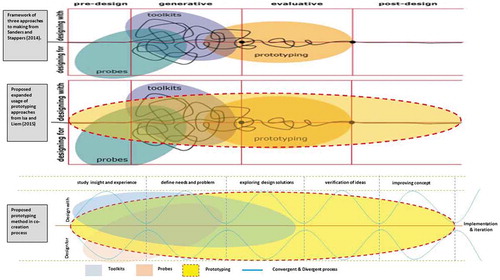
In terms of design practice, clear segmentations between 3-D representation tools (toolkit, probe, prototype) according to the stage of implementation in the design process should be eliminated. Under the general term ‘Prototyping’, as shown in , physical prototypes should be applied in the contexts of both ‘designing for’ (users and other stakeholders as subjects) and in a ‘designing with’ (users and other stakeholders as partners).
In terms of developing new LEGO Products and systems, limiting oneself to existing LEGO pieces in co-creation and prototyping activities is insufficient when exploring new knowledge, themes, and concepts through low-fidelity prototypes. However, when developing a concrete commodity, it would be sufficient to use only LEGO elements in the development stages of the process ().
8. Conclusion
This study shows that high- and low-fidelity prototypes can be applied at the same time and iteratively throughout all stages of the co-creation and design process. This implies that prototyping can be understood as a platform where research and design meet. The purpose of prototyping is not to only represent and generate a final commodity, but also to act as an investigative tool for developing prospective themes, as well as a facilitator for experiential learning and collaborative exploration.
Therefore, making clear distinctions between ‘Prototypes’, ‘Probes’, and ‘Toolkits’ may not be so relevant anymore for LEGO anymore. What matters is how physical prototypes enrich self-reflection and communication activities, with or without the participation of stakeholders in various stages of the co-creation process. On a final note, a more integrated but flexible use of prototypes may enhance the innovation potential in co-creation activities, facilitating the anticipation of future needs.
Disclosure statement
No potential conflict of interest was reported by the author(s).
References
- Ali, A., and A. Liem. 2015. “The Use and Value of Different Co-creation and Tools in the Design Process.” In DS 80-3 Proceedings of the 20th International Conference on Engineering Design (ICED 15) (Vol. 3, pp. 279–288). Milan: Organisation and Management.
- Antorini, Y. M., A. M. Muñiz Jr, and T. Askildsen. 2012. “Collaborating with Customer Communities: Lessons from the LEGO Group.” MIT Sloan Management Review 53 (3): 73–79.
- Bartl, M. 2009. “Towards Human-Centered Design.” The Making of Innovation. http://www.michaelbartl.com/co-creation/wp-content/uploads/HumanCenteredDesign_pdf.pdf
- Bogers, M., and W. Horst. 2014. “Collaborative Prototyping: Cross‐fertilization of Knowledge in Prototype‐driven Problem Solving.” Journal of Product Innovation Management 31 (4): 744–764. doi:10.1111/jpim.2014.31.issue-4.
- Brown, T., and B. Katz. 2019. Change by Design: How Design Thinking Transforms Organizations and Inspires Innovation. Revised, Updated ed. New York: Harper Business.
- Coughlan, P., J. F. Suri, and K. Canales. 2007. “Prototypes as (Design) Tools for Behavioral and Organizational Change A Design-Based Approach to Help Organizations Change Work Behaviors.” JABS 43 (1): 122–134.
- Creswell, J. W., and C. N. Poth. 2016. Qualitative Inquiry and Research Design: Choosing among Five Approaches. Newbury Park, CA: Sage Publications.
- Dann, S. 2018. “Facilitating Co-creation Experience in the Classroom with Lego Serious Play.” Australasian Marketing Journal (AMJ) 26 (2): 121–131. doi:10.1016/j.ausmj.2018.05.013.
- Docherty, P. 2016. “Organising to Ensure Efficient Implementation of Strategy.” This presentation was delivered by LEGO during the Virgin Money Strategy Execution consortium meeting in Newcastle upon Tyne, September 21.
- Dow, S. P., K. Heddleston, and S. R. Klemmer. 2009. “The Efficacy of Prototyping under Time Constraints.” In Proceedings of the Seventh ACM Conference on Creativity and Cognition, 165–174. Berkeley, CA: ACM.
- Eisenhardt, K. M. 1989. “Building Theories from Case Study Research.” Academy of Management Review 14 (4): 532–550. doi:10.5465/amr.1989.4308385.
- Flyvbjerg, B. 2006. “Five Misunderstandings about Case-study Research.” Qualitative Inquiry 12 (2): 219–245. doi:10.1177/1077800405284363.
- Gauntlett, D. 2013. Making Is Connecting. Hoboken, NJ: John Wiley & Sons.
- Gauntlett, D. 2014. “The LEGO System as a Tool for Thinking, Creativity, and Changing the World.” In LEGO Studies: Examining the Building Blocks of a Transmedial Phenomenon, edited by M. J. P. Wolf, 189–205. New York: Routledge.
- Gould, J. D., and C. Lewis. 1985. “Designing for Usability: Key Principles and What Designers Think.” Communications of the ACM 28 (3): 300–311.
- Hallgrimsson, B. 2012. Prototyping and Modelmaking for Product Design. London: Laurence King.
- Heidenreich, S., K. Wittkowski, M. Handrich, and T. Falk. 2015. “The Dark Side of Customer Co-creation: Exploring the Consequences of Failed Co-created Services.” Journal of the Academy of Marketing Science 43 (3): 279–296. doi:10.1007/s11747-014-0387-4.
- Hess, T. 2012. “Investigation of Prototype Roles in Conceptual Design Using Case Study and Protocol Study Methods.” All theses. Paper 1418. https://tigerprints.clemson.edu/all_theses/1418
- Hillson, B. 2013. Sustaining Organizational Culture Change : Discovering How a Designer Can Help Build a Culture of Innovation. Philadelphia (PA): University of the Arts.
- Holmlid, S., and S. Evenson. 2008. “Bringing Service Design to Service Sciences, Management and Engineering.” In IBM, Service Science, Management, and Engineering – Education for the 21st Century, edited by B. Hefley and W. Murphy, 341–345. Boston, MA: Springer.
- Isa, S. S., and A. Liem. 2014. “Classifying Physical Models and Prototypes in the Design Process: A Study on the Economical and Usability Impact of Adopting Models and Prototypes in the Design Process.” In DS 77: Proceedings of the DESIGN 2014 13th International DESIGN Conference, edited by D. Marjanović, M. Štorga, N. Pavković, and N. Bojčetić, 2071–2082. Zagreb: Faculty of Mechanical Engineering and Naval Architecture, University of Zagreb; Glasgow: The Design Society.
- Isa, S. S., A. Liem, and M. Steinert. 2015. “The Value of Prototypes in the Early Design and Development Process.” In DS 80-5 Proceedings of the 20th International Conference on Engineering Design (ICED 15) Vol 5: Design Methods and Tools-Part 1, 235–242. Milan: Design Society.
- Jensen, M. B., C. W. Elverum, and M. Steinert. 2017. “Eliciting Unknown Unknowns with Prototypes: Introducing Prototrials and Prototrial-driven Cultures.” Design Studies 49: 1–31. doi:10.1016/j.destud.2016.12.002.
- Leedy, P. D., and J. E. Ormrod. 2005. Practical Research. Essex, England: Pearson Custom.
- Liedtka, J. 2014. “Innovative Ways Companies are Using Design Thinking.” Strategy & Leadership 42 (2): 40–45. doi:10.1108/SL-01-2014-0004.
- Liem, A., and E. Sanders. 2013. “Human –centered Design Workshop in Collaborative Strategic Design Projects; an Educational and Professional Comparison.” Design and Technology. An International Journal 18: 72–86.
- Liem, A., S. Ruecker, and J. Alfonso de la Rosa. 2017. “Using Studio Teaching as an Initiator and Driver for Research Collaboration in Design.” In DS 87-9: Proceedings of the 21st International Conference on Engineering Design (ICED 17), Vol. 9, 149–158. Vancouver, Canada: Design Education.
- Lim, Y. K., E. Stolterman, and J. Tenenberg. 2008. “The Anatomy of Prototypes: Prototypes as Filters, Prototypes as Manifestations of Design Ideas.” ACM Transactions on Computer-Human Interaction 15 (2): Article No. 7. doi:10.1145/1375761.1375762.
- Mattelmäki, T. 2006. Design Probes. Espoo: Aalto University.
- Mattelmäki, T., and F. Sleeswijk Visser. 2011. “Lost in Co-X: Interpretations of Co-design and Co-creation.” In Proceedings of IASDR’11, 4th World Conference on Design Research, edited by L.-L. Chen and N. Roozenburg, 1–12. Delft: International Association of Societies of Design Research.
- Meinel, C., and L. Leifer. 2011. “Design Thinking Research–Studying Co-Creation in Practice.”
- Neyer, A. K., B. Doll, and K. M. Möslein. 2009. “Mission (Im) Possible?–prototyping Service Innovation.” In Supporting Service Innovation through Knowledge Management: Practical Insights and Case Studies, edited by A. S. Kazi, P. Wolf, and P. Troxler, 143–164. Swiss Knowledge Management Forum.
- Norman, D. A., and R. Verganti. 2014. “Incremental and Radical Innovation: Design Research Vs. Technology and Meaning Change.” Design Issues 30 (1): 78–96. doi:10.1162/DESI_a_00250.
- Prahalad, C. K., and V. Ramaswamy. 2013. The Future of Competition: Co-creating Unique Value with Customers. Brighton, MA: Harvard Business Press.
- Ramli, S. H. 2014. “Mocking Up: Strategies to Engage Expert Users in Designerly Thinking.” PhD diss., Sheffield Hallam University..
- Ranscombe, C., K. Bissett-Johnson, D. Mathias, B. Eisenbart, and B. Hicks. 2019. “Designing with LEGO: Exploring Low Fidelity Visualization as a Trigger for Student Behavior Change toward Idea Fluency.” International Journal of Technology and Design Education 5: 1–22.
- Robertson, D., and B. Breen. 2013. Brick by Brick: How LEGO Rewrote the Rules of Innovation and Conquered the Global Toy Industry. USA: Crown Business.
- Sanders, E. B., and P. Stappers. 2014a. “Probes, Toolkits and Prototypes: Three Approaches to Making in Codesigning.” CoDesign: International Journal of CoCreation in Design and the Arts 10 (1): 5–14. doi:10.1080/15710882.2014.888183.
- Sanders, L., and P. J. Stappers. 2014b. “From Designing to Co-designing to Collective Dreaming: Three Slices in Time.” Interactions 21 (6): 24–33. doi:10.1145/2685354.
- Skogstad, P., and L. Leifer. 2011. “A Unified Innovation Process Model for Engineering Designers and Managers.” In Design Thinking, 19–43. Berlin, Heidelberg: Springer.
- Stowe, D. T. 2008. “Investigating the Role of Physical Prototyping in Engineering Design Using Case Study Validation.” PhD thesis, Clemson University.
- Subramanya, T. N., and B. K. Chakravarthy. 2019. “Standardization of Terminologies for Physical Models in Design Process: Proceedings of ICoRD 2019 Volume 2.” In Research into Design for a Connected World, edited by Amaresh Chakrabarti, 3–20. Singapore: Springer.
- Ulrich, K. T., and S. D. Eppinger. 2012. Product and Design Development. 5th ed. USA: McGraw Hill Companies.
- Verganti, R. 2008. “Design, Meanings, and Radical Innovation: A Metamodel and A Research Agenda.” Journal of Product Innovation Management 25 (5): 436–456. doi:10.1111/jpim.2008.25.issue-5.
- Viswanathan, V. K., and J. S. Linsey. 2009. “Enhancing Student Innovation: Physical Models in the Idea Generation Process.” Paper presented at the 39th ASEE/IEEE Frontiers in Education Conference, San Antonio, TX.
- Wolf, M. J. 2014. LEGO Studies: Examining the Building Blocks of a Transmedial Phenomenon. New York, NY: Routledge.
- Yin, R. K. 2017. Case Study Research and Applications: Design and Methods. USA: Sage Publications.
- Zhang, T., and H. Dong. 2008 Human-centred Design: An Emergent Conceptual Model. Include2009. London: Royal College of Art.

